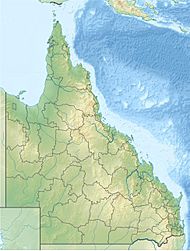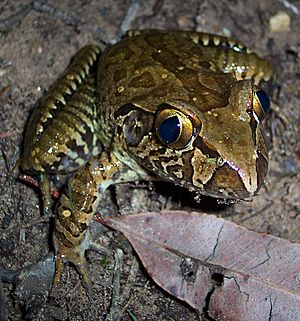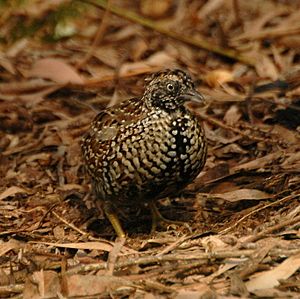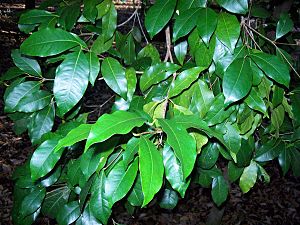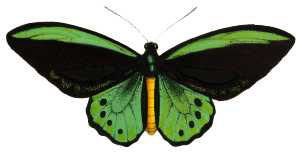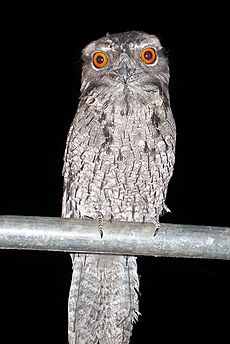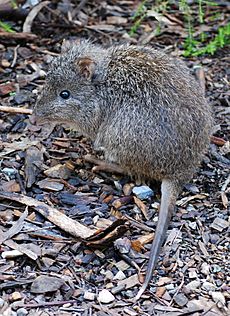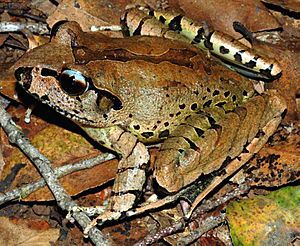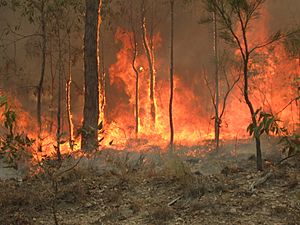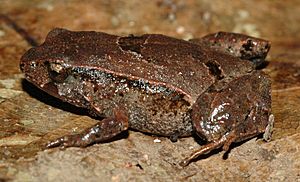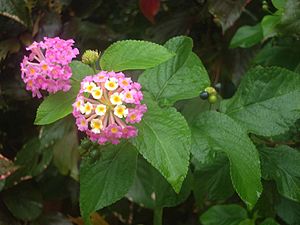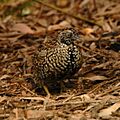Conondale National Park facts for kids
Quick facts for kids Conondale National ParkQueensland |
|
|---|---|
|
IUCN Category II (National Park)
|
|
| Established | 1977 |
| Area | 368 km2 (142.1 sq mi) |
| Managing authorities | Queensland Parks and Wildlife Service |
| Website | Conondale National Park |
| See also | Protected areas of Queensland |
Conondale National Park is a special natural area in Queensland, Australia. It's about 130 kilometers (80 miles) north of Brisbane. You can find it in the Sunshine Coast Hinterland, close to the town of Conondale.
This park is huge, covering about 35,648 hectares (88,088 acres). It protects many different types of forests, like subtropical rainforests and sclerophyll forests. It even has Queensland's tallest tree! Some parts of the park are growing back after being logged a long time ago. The Queensland Government looks after the park to keep it safe.
For over 160 years, the Conondale area was used for farming, mining, and logging. Now, the park is a safe home for many rare and endangered animals and plants. Animals like the plumed frogmouth, giant barred frog, and spotted-tailed quoll live here. The beautiful richmond birdwing butterfly also calls this park home. Sadly, some species, like the southern gastric brooding frog, have disappeared and are now believed to be extinct.
Contents
Exploring Conondale National Park
The park has a very rugged landscape with deep gorges and valleys. There are also several mountains over 700 meters (2,300 feet) high. The tallest peak is Mount Langley, at 868 meters (2,848 feet). You can find beautiful waterfalls and many rocky creeks throughout the park.
The Conondale mountain range helps separate the water that flows into the Brisbane River and the Mary River. Some of the Mary River's smallest streams start here. The park also has important wetlands. These streams are vital for the threatened Mary River cod, a fish that has become rare in these waters.
The Conondale region has a sub-tropical climate. This means it gets about 1,500 millimeters (59 inches) of rain each year. Most of the rain falls in summer (December to March) with heavy downpours. Winters are usually cold and dry, sometimes with frost. The park is home to many plant types, including rainforests, woodlands, and different kinds of sclerophyll forests. Rainforests mostly grow on higher ground and along rivers.
A Look at the Park's Past
The Conondale area was very important to the Jinibara and Kabi Kabi Indigenous people. They used it for travel and to gather food, like the bunya pine nuts. Bunya pines still grow in the park and are culturally important today.
European settlers arrived in the 1860s. They started gold mining, farming, and logging. Trees like red cedar and blackbutt were cut down. By the early 1900s, parts of the forest became state forests. Logging was slowly replaced by planting hoop pine trees.
The national park was created in 1977. This happened after conservationists worked hard to stop logging in untouched areas. They were worried about the impact on water sources and endangered species like the plumed frogmouth. Today, the park is over 35,000 hectares and offers many fun activities. You can go bushwalking, camping, four-wheel driving, horse riding, and bird watching. Many private landowners and Landcare groups have also helped replant trees in the area.
Amazing Plants and Animals
Plants of the Park
A lot of the original plants in the Conondale region were cleared for farms and plantations. But the national park protects large areas of remaining forests. These include subtropical rainforests and different sclerophyll forests. You can still find old bunya pines and hoop pines here. There are also very tall flooded gum and brush box trees. In 2013, Queensland's tallest tree, a flooded gum standing 73 meters (240 feet) tall, was found in the park!
The park has 31 different types of plant communities. Thirteen of these are considered "of concern," meaning they need protection. Some, like gallery rainforests, are even listed as endangered.
In total, 796 plant species have been found in the park. Twelve of these are endangered, vulnerable, or near threatened. One important threatened plant is the gympie nut Macadamia ternifolia. It is now listed as threatened both in Queensland and worldwide.
Saving the Richmond Birdwing Butterfly
Conondale National Park is a very important place for the survival of the richmond birdwing butterfly. This butterfly is listed as vulnerable in Queensland. The park also has many richmond birdwing vines, which are crucial for the butterfly's lifecycle.
The vine is the only plant the female butterfly will lay her eggs on. The butterfly larvae (caterpillars) also eat the vine's leaves. However, an invasive plant called dutchmans pipe is a big threat. Female butterflies are attracted to it and lay their eggs there, but the leaves are deadly to the larvae. To help, there are programs to educate people, plant more vines, remove weeds, and monitor the butterflies.
Birds of Conondale
Conondale National Park is recognized as an Important Bird Area. This means it's a key place for bird conservation. About 174 bird species have been seen here, and 14 of them are endangered or vulnerable. Some notable birds include the pale-yellow robin, paradise riflebird, and regent bowerbird.
Threatened birds in the park include the coxin's fig parrot, red goshawk, and the powerful owl. The Conondale ranges are also a vital northern refuge for the eastern bristlebird. This small, semi-flightless bird needs dense plant cover and is sensitive to fire. It used to be common but has declined. Park managers are working to protect its habitat and help it recover.
The plumed frogmouth is another vulnerable bird in Queensland. It was only discovered in the Conondale ranges in 1976. The national park is now a strong home for this species. It lives in subtropical rainforests at high altitudes. Its population is threatened by land clearing, bad fire management, and climate change.
The black-breasted button-quail is a small bird that lives on the ground. It prefers dry rainforests. About 90% of its habitat has been cleared. Less than 2,500 of these birds are thought to remain in the wild. The Conondale population is very important because of its size and location within a national park.
Mammals of the Park
Sixty-eight different types of mammals have been recorded in the park. Many are uncommon or only found in certain areas. These include the yellow-bellied glider, koala, and grey-headed flying-fox.
The rufous bettong, the largest of the potoroos, also lives here. It eats roots and fungi at night. Threats to this animal include changes in fire patterns and too much grazing. The long-nosed potoroo is also found in the park and is listed as vulnerable. It is threatened by foxes and land clearing.
The spotted-tail quoll, Australia's largest surviving marsupial predator, has been seen in the park. Its numbers have dropped a lot in Queensland. This is due to habitat loss, logging, poisons, and predators.
Frogs and Amphibians
Thirty-one species of frogs live in the Conondale ranges. The endangered giant barred frog lives here, which is its northernmost home. Other threatened frogs include Fleay's barred frog and the vulnerable tusked frog. Programs are in place to monitor and help these threatened species.
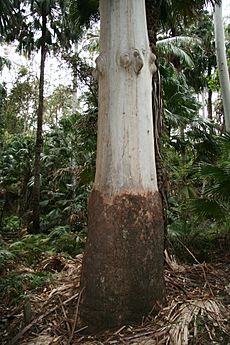
The Conondale region has seen a rapid decline in frog populations. The southern gastric brooding frog and the southern dayfrog both disappeared between 1979 and 1981. They are now presumed extinct. Four other frog species in the park have also declined. Scientists are still trying to find out why. One possible cause is a disease called chytrid fungus.
Reptiles of Conondale
There are 54 species of reptiles recorded in the park. These include the rough-scaled snake, lace monitor, and carpet python. The near-threatened challenger skink also lives here. It is found in rainforests and sometimes in thickets of the invasive plant Lantana camara.
Amazing Invertebrates
The Conondale crayfish is a unique creature found only in rainforest streams in the Conondale and Blackall Ranges. Conondale National Park is one of its main strongholds. This crayfish digs burrows in streams at higher elevations. It is endangered because it can't handle big changes in climate and is sensitive to extreme weather. Feral pigs also threaten it by destroying its burrows and stream banks.
Protecting the Park
The Mystery of the Disappearing Frogs
The southern gastric brooding frog was discovered in 1973. It had a very unusual way of reproducing: the mother would swallow her eggs, and the tadpoles would grow inside her stomach! They would then be born through her mouth. This frog was common in rocky streams. But in 1979, its numbers dropped quickly, and it hasn't been seen since 1981. The southern dayfrog also disappeared around the same time. Both are now believed to be extinct.
Scientists have many ideas about why these frogs disappeared. One possible cause is the chytrid fungus. This fungus has caused declines in many frogs around the world, especially in undisturbed rainforests. The Australian government has identified chytrid fungus as a major threat to stream frogs.
Threats from Nearby Forests
The national park is next to state forests and hoop pine plantations. These areas are still harvested for timber. This can threaten animals like the black-breasted button-quail and the plumed frogmouth, which need untouched forests. Logging operations can also cause more siltation and erosion in streams, affecting water quality.
Managing Fire
Fire can have a big impact on the park's species. Studies show that eastern bristlebirds do well with controlled fires that create a mosaic of burnt and unburnt areas. This allows the birds to move to safe spots after a fire. It's also important to control feral animals like cats and foxes after fires, as birds are more vulnerable.
Other species, like the black-breasted button-quail, are also sensitive to fire. The park has a fire management plan.
Climate Change Impacts
Climate change is a major threat to plants and animals worldwide. Frogs are especially sensitive to changes in climate. Several species in Conondale National Park are vulnerable to climate change. These include Fleay's barred frog, the pouched frog, and the plumed frogmouth. The Conondale crayfish is also sensitive to temperature changes.
Controlling Pests
The park has a plan to manage invasive plants, also known as weeds. These include lantana, dutchmans pipe, and cat's claw creeper. These weeds threaten important species like the richmond birdwing butterfly and the eastern bristlebird.
Feral animals also harm native species and their habitats. These include cats, foxes, and wild dogs. They threaten small ground-dwelling mammals and birds like the eastern bristlebird. Feral pigs are managed through trapping and baiting to protect eastern bristlebirds, long-nosed potoroos, and black-breasted button-quails. Red deer also impact the habitat of frogs and eastern bristlebirds.
Images for kids
-
Flooded gum Eucalyptus grandis
See also
 In Spanish: Parque nacional Conondale para niños
In Spanish: Parque nacional Conondale para niños


